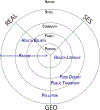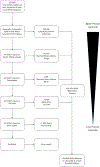Geospatial analysis of patients' social determinants of health for health systems science and disparity research
- PMID: 36480649
- PMCID: PMC10107426
- DOI: 10.1097/AIA.0000000000000389
Geospatial analysis of patients' social determinants of health for health systems science and disparity research
Abstract
Social context matters for health, healthcare processes/quality and patient outcomes. The social status and circumstances we are born into, grow up in and live under, are called social determinants of health; they drive our health, and how we access and experience care; they are the fundamental causes of disease outcomes. Such circumstances are influenced heavily by our location through neighborhood context, which relates to support networks. Geography can influence proximity to resources and is an important dimension of social determinants of health, which also encompass race/ethnicity, language, health literacy, gender identity, social capital, wealth and income. Beginning with an explanation of social determinants, we explore the use of Geospatial Analysis methods and geocoding, including the importance of collaborating with geography experts, the pitfalls of geocoding, and how geographic analysis can help us to understand patient populations within the context of Social Determinants of Health. We then explain mechanisms and methods of geospatial analysis with two examples: (1) Bayesian hierarchical regression with crossed random effects and (2) discontinuity regression i.e., change point analysis. We leveraged the local University of Utah and Yale cohorts of the Multicenter Perioperative Outcomes Group (
Conflict of interest statement
Conflict of interests
Dr. Schonberger reports owning stock in Johnson & Johnson unrelated to the present work. Dr. Schonberger reports that his organization receives funding from Merck, Inc. for a study in which he is co-investigator unrelated to the present work. Dr. Andreae is part of a study funded by Merck unrelated to the present work. No other author has any conflicts to declare.
Figures





References
-
- Gavrilova ML. Generalized Voronoi diagram : a geometry-based approach to computational intelligence. Berlin; London: Springer; 2008. xxi, 312 p. p.
Publication types
MeSH terms
Grants and funding
LinkOut - more resources
Full Text Sources

